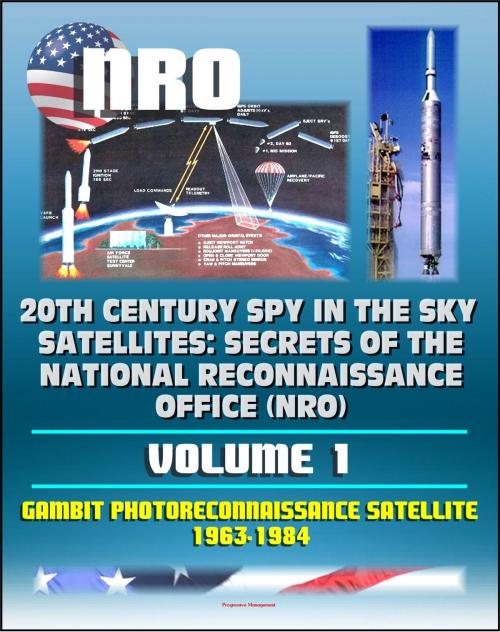20th Century Spy in the Sky Satellites: Secrets of the National Reconnaissance Office (NRO) Volume 1 - Gambit Photoreconnaissance Satellite 1963-1984
Nonfiction, Science & Nature, Technology, Military Science, History, Military| Author: | Progressive Management | ISBN: | 9781465824967 |
| Publisher: | Progressive Management | Publication: | October 3, 2011 |
| Imprint: | Smashwords Edition | Language: | English |
| Author: | Progressive Management |
| ISBN: | 9781465824967 |
| Publisher: | Progressive Management |
| Publication: | October 3, 2011 |
| Imprint: | Smashwords Edition |
| Language: | English |
Part of our comprehensive series on the National Reconnaissance Office (NRO) and its "spy satellite" network, this volume covers the Gambit photoreconnaissance satellite flown between 1963 and 1984. The previously classified documents in this collection, converted for accurate flowing-text e-book format reproduction, were released by the NRO in September 2011 as part of its 50th anniversary. In declassifying these fascinating documents, the NRO has opened the curtain to show the tremendous challenges that were overcome to achieve the impressive successes that help win the Cold War.
CORONA was the first successful program in applying space vehicles to overflight reconnaissance operations. In its several evolutionary versions, CORONA steadily improved its photographic surveys of denied areas (with final resolutions of six to ten feet), operating in what the Intelligence Community calls "search mode." GAMBIT was developed to perform at even better resolutions than CORONA and work against specified targets—an operation usually referred to as "surveillance mode." GAMBIT fulfilled this surveillance function from July 1963 to April 1984.
Although Corona provided the capability to search large areas from space, the U.S. still lacked high resolution imagery. Approximately one year after the first launch of Corona, the National Reconnaissance Office began development of its first high resolution satellite program, codenamed Gambit. Over time, the Gambit program evolved into two different systems. The first Gambit system, launched in 1963, was equipped with the KH-7 camera system that included a 77-inch focal length camera for providing specific information on scientific and technical capabilities that threatened the nation. Intelligence users often characterized this capability as surveillance, allowing the United States to track the advancement of Soviet and others' capabilities. The second system, Gambit 3 was equipped with the KH-8 camera system that included a 175-inch focal length camera. The system was first launched in 1966 and provided the U.S. with exquisite surveillance capabilities from space for nearly two decades. The NRO launched a final system, codenamed Hexagon, in 1971 to improve upon Corona's capability to search broad and wide denied areas for threats to the United States. The system sometimes carried a mapping camera to aid in U.S. military war planning. The United States depended on these search and surveillance satellites to understand the capabilities, intentions, and advancements of those who opposed the United States during the Cold War. Together they became America's essential eyes in space.
Here is an excerpt from one of the documents about Gambit: "Earlier in the day the launch crew had notified Greer that during the final checkout they had uncovered a fault in the Atlas booster that would either force delay or cause reliance on a component not tested to the extent required by specifications. Shouldering aside the oppressive memory of unbroken failures and "partial successes" in the E-5 and E-6 programs, Greer ordered continuation of the countdown. It was a personal decision, taken without consultation with others, based as much on instinct as on the confidence of a program director who had done all that could be done to insure success. For an instant during the launch itself, most observers experienced the horrified conviction that the decision had been wrong, that disaster had come again to the Air Force satellite reconnaissance program. The splashing rocket exhaust of the Atlas knocked out all electrical connections to telemetry and cameras, giving the impression of a major launch stand explosion to observers at Sunnyvale and El Segundo. But seconds later the signals began to come through again, and they said that the Atlas was climbing stolidly toward its selected launch window."
Part of our comprehensive series on the National Reconnaissance Office (NRO) and its "spy satellite" network, this volume covers the Gambit photoreconnaissance satellite flown between 1963 and 1984. The previously classified documents in this collection, converted for accurate flowing-text e-book format reproduction, were released by the NRO in September 2011 as part of its 50th anniversary. In declassifying these fascinating documents, the NRO has opened the curtain to show the tremendous challenges that were overcome to achieve the impressive successes that help win the Cold War.
CORONA was the first successful program in applying space vehicles to overflight reconnaissance operations. In its several evolutionary versions, CORONA steadily improved its photographic surveys of denied areas (with final resolutions of six to ten feet), operating in what the Intelligence Community calls "search mode." GAMBIT was developed to perform at even better resolutions than CORONA and work against specified targets—an operation usually referred to as "surveillance mode." GAMBIT fulfilled this surveillance function from July 1963 to April 1984.
Although Corona provided the capability to search large areas from space, the U.S. still lacked high resolution imagery. Approximately one year after the first launch of Corona, the National Reconnaissance Office began development of its first high resolution satellite program, codenamed Gambit. Over time, the Gambit program evolved into two different systems. The first Gambit system, launched in 1963, was equipped with the KH-7 camera system that included a 77-inch focal length camera for providing specific information on scientific and technical capabilities that threatened the nation. Intelligence users often characterized this capability as surveillance, allowing the United States to track the advancement of Soviet and others' capabilities. The second system, Gambit 3 was equipped with the KH-8 camera system that included a 175-inch focal length camera. The system was first launched in 1966 and provided the U.S. with exquisite surveillance capabilities from space for nearly two decades. The NRO launched a final system, codenamed Hexagon, in 1971 to improve upon Corona's capability to search broad and wide denied areas for threats to the United States. The system sometimes carried a mapping camera to aid in U.S. military war planning. The United States depended on these search and surveillance satellites to understand the capabilities, intentions, and advancements of those who opposed the United States during the Cold War. Together they became America's essential eyes in space.
Here is an excerpt from one of the documents about Gambit: "Earlier in the day the launch crew had notified Greer that during the final checkout they had uncovered a fault in the Atlas booster that would either force delay or cause reliance on a component not tested to the extent required by specifications. Shouldering aside the oppressive memory of unbroken failures and "partial successes" in the E-5 and E-6 programs, Greer ordered continuation of the countdown. It was a personal decision, taken without consultation with others, based as much on instinct as on the confidence of a program director who had done all that could be done to insure success. For an instant during the launch itself, most observers experienced the horrified conviction that the decision had been wrong, that disaster had come again to the Air Force satellite reconnaissance program. The splashing rocket exhaust of the Atlas knocked out all electrical connections to telemetry and cameras, giving the impression of a major launch stand explosion to observers at Sunnyvale and El Segundo. But seconds later the signals began to come through again, and they said that the Atlas was climbing stolidly toward its selected launch window."















